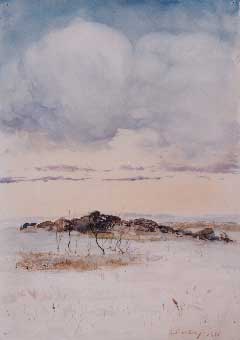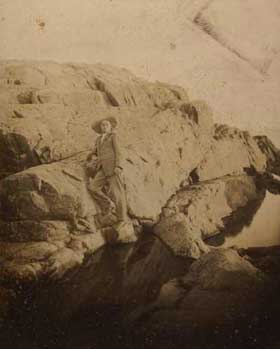Paris Salon Essays
Essay #3
Before the Rage of Paris...Antwerp Academie of Beaux Arts
by Catherine Little Bert
 This week's
essay is Part one, a look into the Rhode Island artist Elijah Baxter. In last week’s Providence Journal review of the current Bert Gallery exhibit, art critic Bill van
Siclen noted, “Other highlights include...[a] group of small landscapes and beach scenes by the relatively unheralded Elijah Baxter.”
This week's
essay is Part one, a look into the Rhode Island artist Elijah Baxter. In last week’s Providence Journal review of the current Bert Gallery exhibit, art critic Bill van
Siclen noted, “Other highlights include...[a] group of small landscapes and beach scenes by the relatively unheralded Elijah Baxter.”
Given this observation, it seemed fitting to explore Baxter in depth. Especially in light of his European art instruction at Antwerp as opposed to Paris.
Elijah Baxter, a painter of the rugged New
England landscape is a relatively obscure painter to most Rhode Island and American collectors as well as museums. Difficult to believe from his photo, an artist of supreme
confidence, excellently dressed, strategically photographed against the backdrop of the jagged boulders of Newport’s Spouting Rocks, a stone's throw away from the posh
Bailey’s Beach.
Why is he relatively unknown? Elijah Baxter, son of sea captain had evident artistic talent. Critics wrote of his painting acumen...
Atlantic
Monthly ...Mr. Baxter has real genius for landscape
New York Tribune. In these days of mere verbiage in art, it is refreshing to observe subtle artistic qualities
with deep poetic meaning.
All of these reviews came to Baxter before the age of 34.
Again we ask the question why present day obscurity when Elijah Baxter had many prominent friends and clients. His first paintings were purchased by Mayor Doyle, Chief Justice Charles Bradley, industrialists Henry J. Steere and Jesse Metcalf. The “boy” Governor William Sprague financed his education and J.P. Morgan’s friend and stockbroker Henry Clews provided the artist with studio space on his prominent Newport estate.
The obscurity of artist Elijah Baxter is just another tale of a successful and prominent Rhode Island artist lost to the rapidly changing fashions and trends of the art world and the lack of interest in local art history. But, as you can well imagine when scanning a photo of the artist, Elijah Baxter has left behind a hot trail to follow for researchers and art enthusiasts. There are a significant body of paintings to document his talent and a paper trail of exhibitions, photographs and family papers to gain insight into his determined and buoyant personality.
 Baxter is a many faceted artistic character. On some levels his life reads like a fairy tale of intrigue and suspense as he
navigates among the prominent men and women of Rhode Island, an important and necessary patron class to engage for an artist of the late 19th century.
Baxter is a many faceted artistic character. On some levels his life reads like a fairy tale of intrigue and suspense as he
navigates among the prominent men and women of Rhode Island, an important and necessary patron class to engage for an artist of the late 19th century.
His father settled in Providence after a series of ups and downs in his shipping business. Baxter was raised in his early years in Hyannis, reasonably educated for the time, achieving a Grammar school education and self tutelage among the plentiful supply of books on board his home on the ship “Yarmouth.” After leaving Hyannis and nine years of life at sea his father abandoned the great waves to seek employment on the shore for himself and his son. Young Elijah (age 18) commenced his employment at the very same jewelry establishment, Sackett and Davis, which noted Rhode Island portrait painter John Arnold had been employed yet 13 years before.
Baxter’s career as a jeweler was short lived after the owner Hon. Thomas Davis discovered Baxter’s talent for mural painting in the business’s loft. Instead of firing the young man for slacking off, Mr. Davis became Elijah’s first art patron, funding his art study with John Arnold. Baxter’s talent quickly developed as well as his desire to become a full time artist. Within a short time the young painter inspired artist friends to donate their own artwork for a charity auction to raise money on Baxter’s behalf to pursue a full time art career in Providence, studio loft and all.
Ever the charming personality, Baxter sold his first painting to ex-Mayor, Honorable Thomas Doyle, the mayor in turn introduced Baxter to the very prominent and very wealthy Sprague family. (Some estimate their wealth in 1860 to be about 25 million.) Fanny Sprague likewise enthralled by the young artist included Elijah in all of the family affairs and by the age of 20 Baxter was on his way to Europe for serious art study under the patronage of the Sprague’s.
Baxter was between the privileged Rhode Island and American artists to gain intense instruction abroad. For him it was onto the fine arts school of the Academie des Beaux Arts in at Antwerp, Belgium. Remember that his first two years of art instruction stateside was typical of most American artists. Tutelage from an established artist in the community, in his case, John Arnold, and access to artistic materials by the core artistic generation in Providence that would be the 1855 group of Robinson, Waterman, Lewin, Arnold and Batcheller.
But this was nothing compared to the rigors and depth of the Antwerp Academie of Beaux Arts. The day began at six o'clock in the morning for two hours of drawing before breakfast, then drawing from nine to noon. Onto three hours of afternoon studio work to be followed by lectures in the evening on anatomy, costume, perspective and history. The long, arduous days at Antwerp were further enhanced by the young artist’s excursions to Ghent to study the old master paintings on church altars and visits to the history museum at Brussels. Baxter certainly learned the discipline and skills that would make for a successful artist, but he also exerted early on self-determination. Defying the appeals of his professor as well as the ridicule of fellow students, he would forgo the afternoon studio landscape painting class and insisted on outdoor painting where he could experience and paint nature directly. This stubborn breakout yielded an artist who would create inspired landscapes much admired by fellow artists and critics alike for years to come.
Next week’s essay will cover Baxter’s return to Providence and his artistic career stateside. It is important to note that art study atAntwerp was indeed very structured compared to Paris. In Paris most of the days were spent with many other students sketching the live model provided by the school and then receiving critiques from the instructor throughout the week. Paris instruction came primarily from critique and competition with fellow students. Antwerp was a more formal day with classroom instruction coupled with studio. It is not clear why Baxter sought art instruction in Antwerp over Paris; it might have had to do with the Sprague’s as his patron having this preference.
